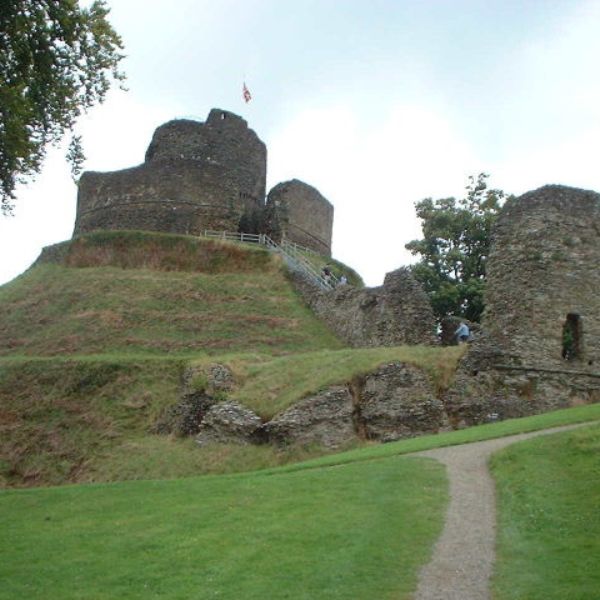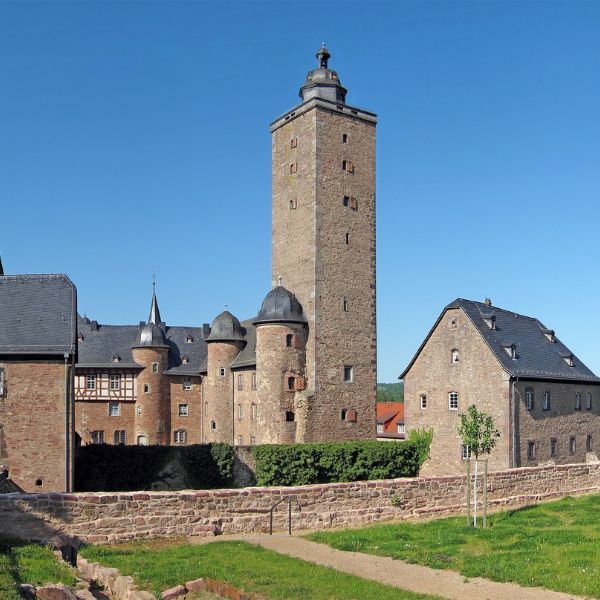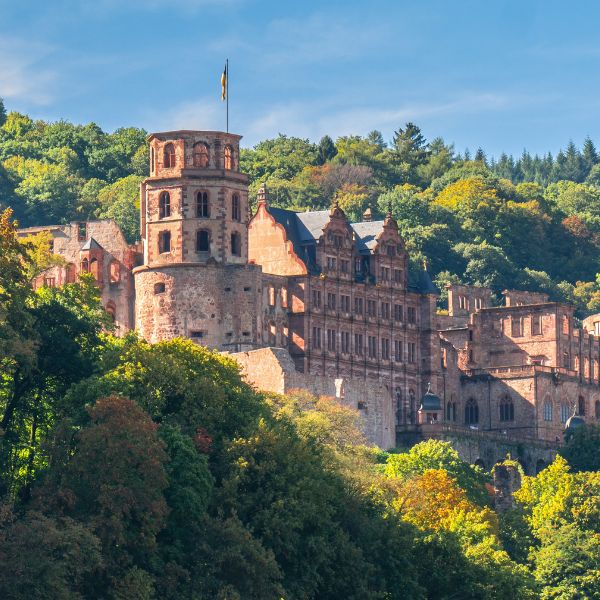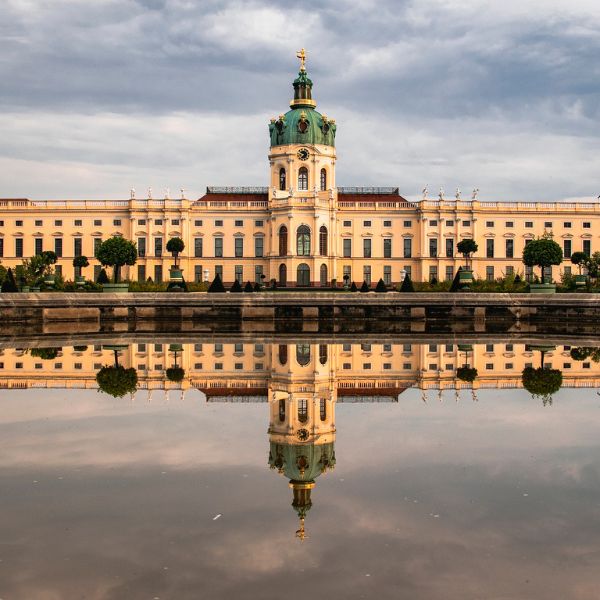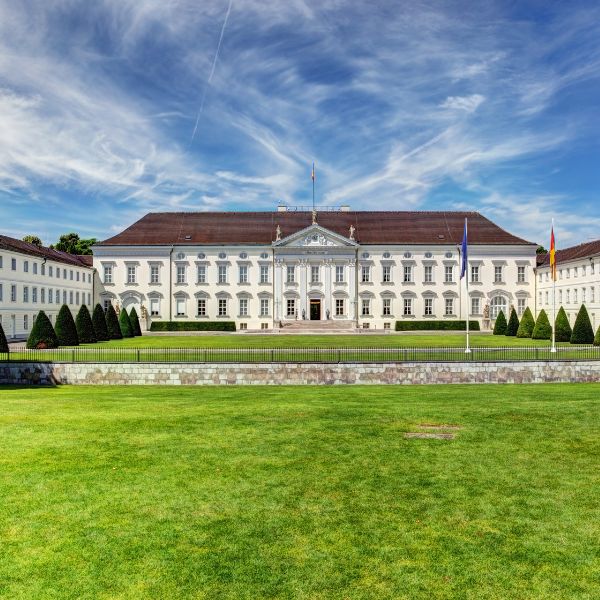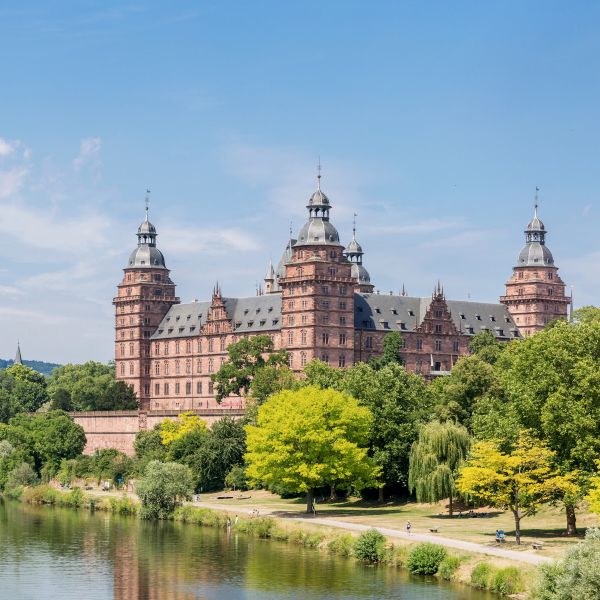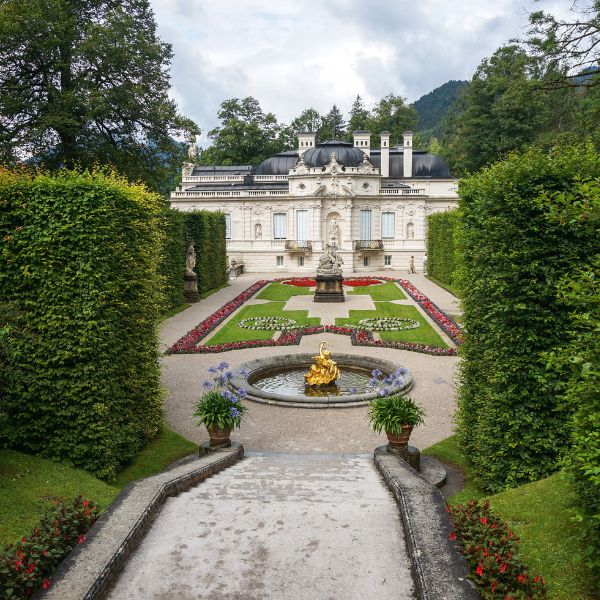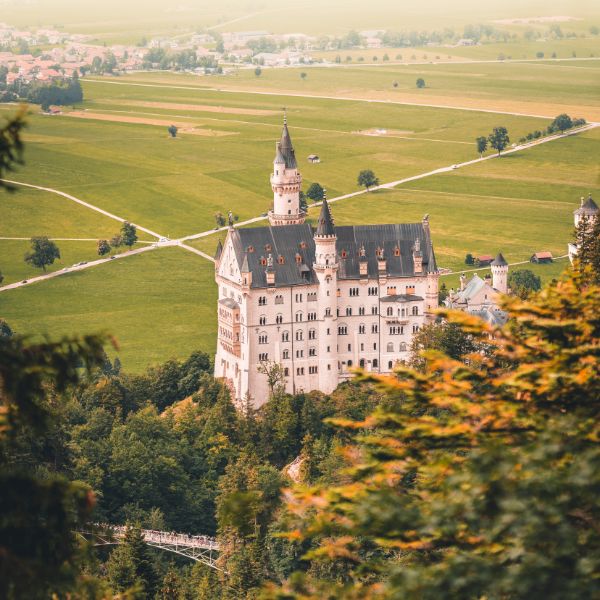- Home
- Difference between Palace and Castle
What's the Difference Between Palace and Castle?
By: Lydia Fulson / Writer, Pyrography Artist, Thrill Seeker, and Traveler
How does one know the difference between palace and castle? Is there a hidden secret in the architecture? In the names? Or is the difference left in the past? Let's talk about it!
Germany has hundreds of castles deep in hidden valleys, in secluded forests, and many tower over their surrounding cities high on a hill. The hilltop Heidelberg and Reichsburg castles near Frankfurt are wunderbar examples of castles keeping watch over their towns.
There is a multitude of castles and palaces scattered about. There must be a way to tell which is which. But how? We'll start by breaking it down, right to the roots, and it all starts with a little bit of history.
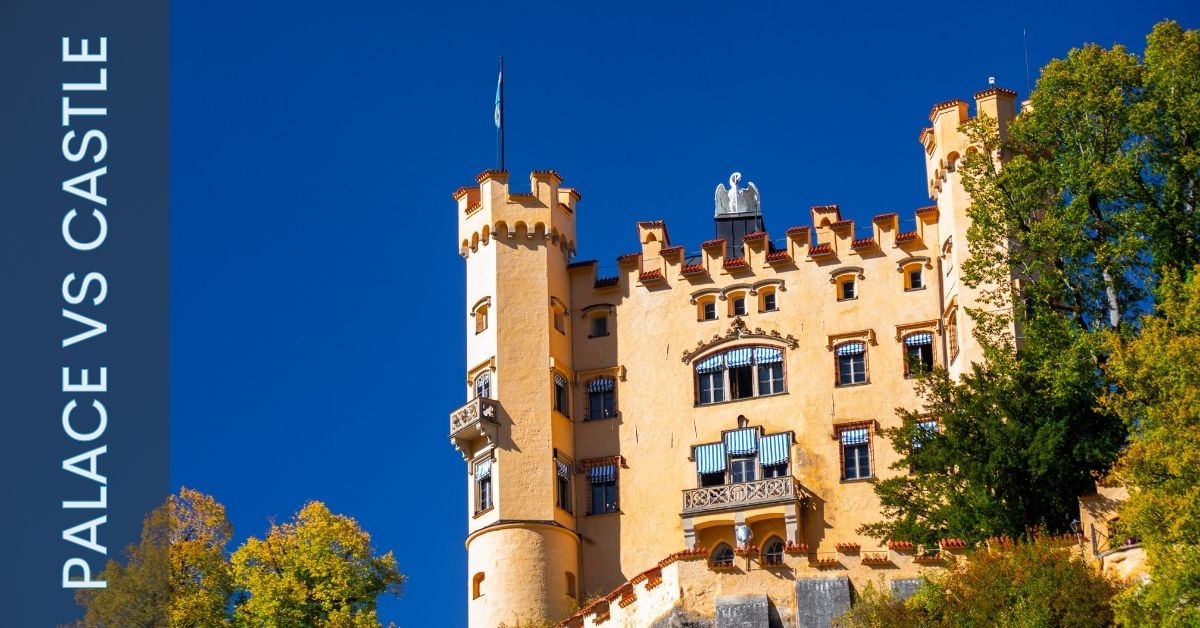 Hohenschwangau hiding out in the beautiful Bavarian mountains
Hohenschwangau hiding out in the beautiful Bavarian mountainsOn this page:
Germany's Oldest Castle!
Die Meersburg is one of Germany's oldest castles on record. The exact date of its creation and design has yet to be discovered, but parts of the structure have been dated back to the 7th century!
The majority was built during the 12th century. Parts like the central keep and the huge stones at the base of the castle's great tower have historians certain that they were built during the late 6th-early 7th century.
Meersburg housed Dukes, bishops, and the best of the best.
In 1897, a Munich man named Carl Mayer von Mayerfels bought the great fortress. What makes this purchase so amusing is his occupation. Carl was a medieval researcher. How funny is it that a medieval prodigy bought a castle that didn't just dabble in the medieval lifestyle but hosted it for hundreds of years?
A famous and culturally significant writer and poet, Annette von Droste-Hülshoff, also took residence here, wrote one of her most famous poems during her stay, and even dedicated it to the castle: '1841/42 Das Alte Schloss'.
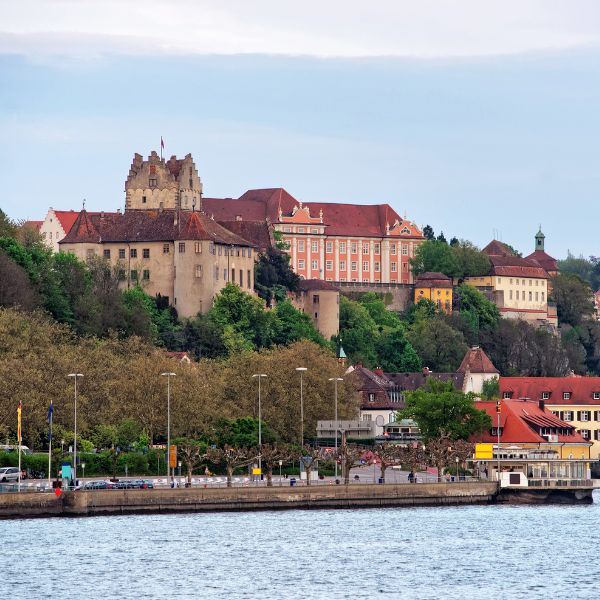 Behold! One of Germany's oldest castles: Meersburg
Behold! One of Germany's oldest castles: MeersburgLet's fast forward to the future. The castle was opened to the public in the 19th century and now hosts thousands of visitors a year. When touring Meersburg, there are multiple rooms to see including a museum that Carl opened himself.
See 30 rooms that these famous folk once wrote and researched in. Tour the kitchen, weapon hall, and stables. Even the castle dungeon can be toured! Get a load of that nifty Middle Ages weaponry!
It's unknown if this was Germany's first castle ever built. But it is one of the oldest on record and one of the oldest still inhabited. That's right. People actually live in there, and they are related to Carl Mayer von Mayerfels. A few years down on the family tree, of course.
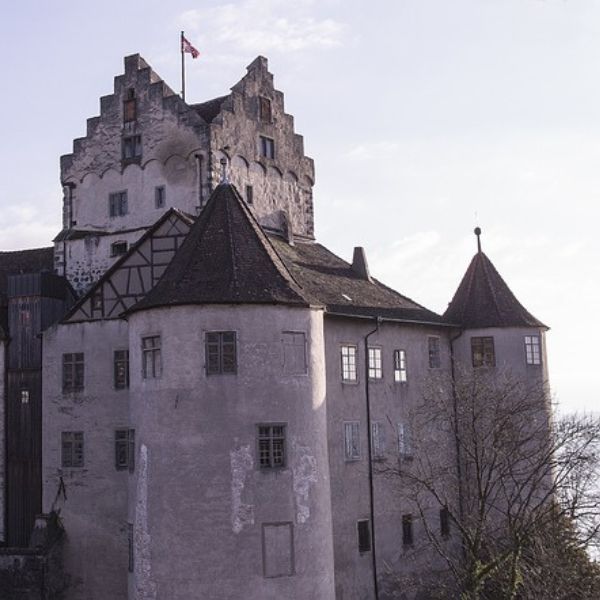 Feast your eyes on some of the oldest stone work in Germany
Feast your eyes on some of the oldest stone work in GermanyThe Castle's Purpose
What's the meaning?
The word 'castle' means: “a large building, typically of the medieval period, fortified against attack with thick walls, battlements, towers, and in many cases a moat.”
Castles have been around for centuries upon centuries.
The Romans were quick to start the trend, building their first castles as early as 100 BC! The rest of Europe was a bit later to the castle-building trend, and Germany only built its variety of castles years after the rest of Europe.
But what was the purpose?
The original purpose of the castle was to be used as a stronghold for military purposes. Castles were essentially defensive structures. They would be decked out with defensive features like large, strong walls, drawbridges, moats, and tall towers for the archers and other weaponry to be fired from upon battle, which gave a strategic advantage.
Though the castle's purpose was to take all the harshness of war and battle, some truly beautiful castles are out there. Castle architecture came a long way to ensure it was ready to face enemy attack.
Types of Castles
Motte & Bailey Castles:
What's the meaning?
"This unusual name comes from France. Motte means 'mound' and bailey means 'closed/fenced-in' land."
"A style of castle built on a mount called a motte, overlooking a courtyard known as the bailey."
The motte and bailey castles have more of a rounded structure to them. The motte refers to the castle's keep, and the bailey refers to its fortified walls and surrounding courtyard. The keep would typically be positioned higher up on a hill for more protection. The bailey is what gives a rounded look.
This castle is a great example of a motte and bailey system working together to make an impenetrable fortress.
The architectural purpose of the keep's placement was critical for battle. Designing where the castle would go was also very important. Most builders would start with land that already had a tall enough hill on it, and that's where the motte/keep would be placed. Otherwise, a large mound of dirt would be built up and then built on. Then, the defensive walls go up!
The next round of castle types is solely based on the majestic castle keep.
Square Stone Keep Castles:
The castle Steinau and its towering square stone keep is the perfect example for this category! It's tall, it's dominant, and it's, well, … stone and square!
These keeps were sometimes used to store loads of food and ammunition during attacks. This was a safe spot to keep the food from being destroyed, and the people wouldn't go hungry during these battles that could last days!
Round Keep Castles:
The beautiful Heidelberg shows off its round keep, which matches many other castles keep towers in Europe. Why is this architectural style so popular?
It's strong! And that's what mattered back then.
Rulers and builders started to notice that the enemy would aim for the corners of the square towers more often, seeing the corners as a visible weak spot to take them down. So, the castles started to be built with rounded towers instead. The safer, the better! Plus, it looks pretty cool too.
There, of course, were many more styles and architectural designs that served some beneficial purpose that was just as popular as these. Like the Gothic brick styles.
We could go on about these impressive structures all day. Who knew so much went into planning these immaculate castles? Now, let's get into some palaces.
Palaces in Germany
There are many splendid and stunning palaces in Germany's states and cities to visit, and these below are just a few.
Most palaces in Germany and worldwide share common architectural features such as often being built rectangular, having high ceilings, hundreds of windows displaying expensive glass, arches, cone towers, and the most dramatic lighting.
Ludwig's Palaces:
King Ludwig of Bavaria was a popular builder and designer of a handful of palaces throughout Bavaria. The majestic Linderhof and its elaborate designs are the most famous of his palaces.
If you've got it, flaunt it, right?
In this case, he had the money, and boy did he ever spend it! Palaces this grand come with hefty price tags. He did a fine job making it as fabulous as his eccentric taste was. See the Linderhof up close in person and step into the life of a wealthy palace owner.
See Castles in Bavaria to learn more about this magnificent palace and its hidden gem features that make this a palace worth visiting!
The Palace's Purpose
What's the meaning?
The word 'palace' means: “the official residence of a sovereign, archbishop, bishop, or other exalted person”
Or, “a large, splendid house.”
These elaborate buildings and major tourist attractions were made entirely for the reason of sitting and looking pretty. The richer the owner, the fancier the things! Palaces were built to show who had the riches and clearly showed who didn't. Who had high superiority? Just scope the area for a palace!
This meaning really shows in palaces around the world, like the spacious halls of the Palace of Versailles west of Paris. Versailles served as a royal residence and is now known for its amazing architecture, both inside and out.
There isn't one inch of this place that doesn't reflect the riches of the King. No details were missed in creating this masterpiece, from the gold leaf trims to the marble detailing, massive chandeliers, and beautiful gardens.
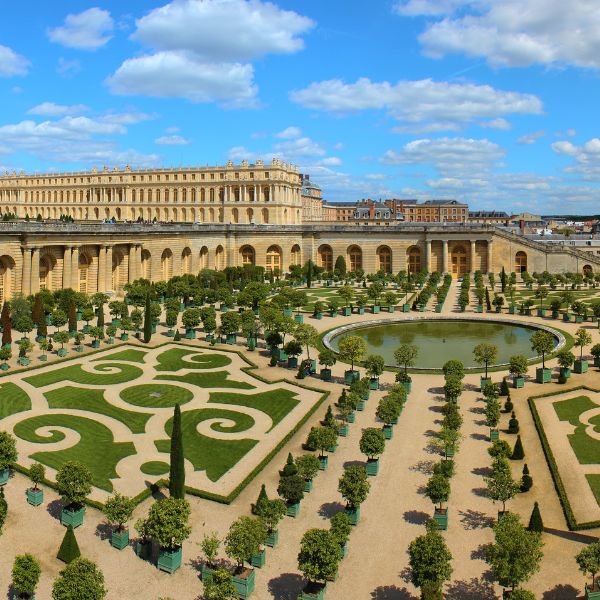 Palace of Versailles: the most intricate of palace gardens. There are no words!
Palace of Versailles: the most intricate of palace gardens. There are no words!Check out those INCREDIBLE designs. Imagine how long it must take to manicure these perfect greens.
The first palaces on record were built in Egypt and were housed by cultural leaders and high-ranking individuals. Palaces in different areas of the world were built for looks or as elaborate homes for government-ranked folks, such as bishops or kings. This kind of goes against the classic saying “The King of the Castle.” Right?
But let's talk about King Ludwig for a minute.
He built the Linderhof palace to show off his wealth and love of the arts. He also had Neuschwanstein Castle built. But this wasn't for battle or taking defensive measures. It, too, was to show off his wealth. He even had an entire opera room and a stage dedicated to his favorite opera writer! Oh, the things money can do.
What's The Verdict?
So, this brings back the question, “Is there a difference between castles and palaces anymore?”. If castles were used in times of battle and defense, why did Ludwig build castles to show off his wealth?
After learning all of this, what may shock you is that not ALL castles kept being built for these military purposes.
Throughout the decades of change, some castles were just built to be built: some to show high superiority, some for looks, and some still for battle and to show strength.
The main reason for the builds did dwindle off in the later centuries. Then, castles and palaces started to see more similarities vs. differences. Though starting off, that difference was crucial and meant everything!
No matter the purpose, history sure did leave us all with some breathtaking castles and palaces to feast our eyes on. There's a style for everyone.

